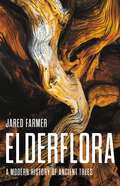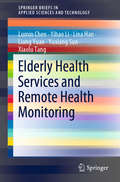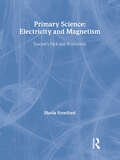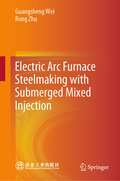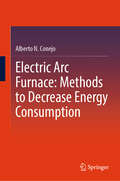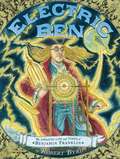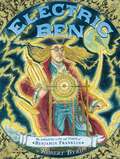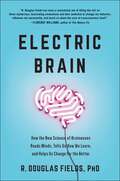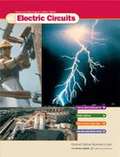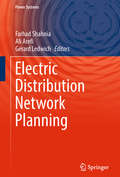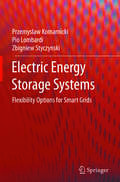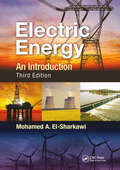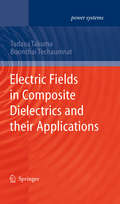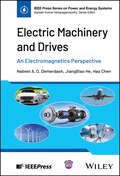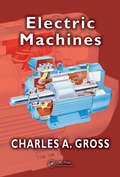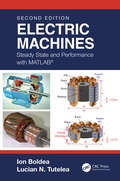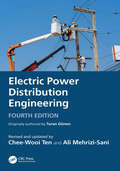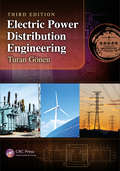- Table View
- List View
Elderflora: A Modern History of Ancient Trees
by Jared FarmerThe epic story of the planet&’s oldest trees and the making of the modern world Humans have always revered long-lived trees. But as historian Jared Farmer reveals in Elderflora, our veneration took a modern turn in the eighteenth century, when naturalists embarked on a quest to locate and precisely date the oldest living things on earth. The new science of tree time prompted travelers to visit ancient specimens and conservationists to protect sacred groves. Exploitation accompanied sanctification, as old-growth forests succumbed to imperial expansion and the industrial revolution. Taking us from Lebanon to New Zealand to California, Farmer surveys the complex history of the world&’s oldest trees, including voices of Indigenous peoples, religious figures, and contemporary scientists who study elderflora in crisis. In a changing climate, a long future is still possible, Farmer shows, but only if we give care to young things that might grow old.Winner of the 2023 Jacques Barzun Prize in Cultural History
Elderly Health Services and Remote Health Monitoring (SpringerBriefs in Applied Sciences and Technology)
by Lina Han Yihao Li Lumin Chen Liang Yuan Yuxiang Sun Xiaolu TangThis book focuses on typical health services and remote monitoring methods, such as visual recognition and deep learning. Chiefly addressing the design and simulation of rehabilitation devices, and the evaluation of their effects on various diseases, it offers a valuable resource for professional researchers and graduate students in the fields of elderly medicine, signal processing, and rehabilitation.
Elect&Mag Prim Sci: Teacher's Cd-rom Pack For Key Stages 1 And 2
by Fabienne Brochier Mike Diprose Nabeel Nasser Sheila StratfordFirst published in 2004. Routledge is an imprint of Taylor & Francis, an informa company.
Electric Arc Furnace Steelmaking with Submerged Mixed Injection
by Rong Zhu Guangsheng WeiThis book focuses on the study of electric arc furnace (EAF) steelmaking with submerged injection. The new EAF process with submerged mixed injection was first proposed and applied by the authors. It analyzes the mechanism of submerged O2-CaO and carbon powder injection, the impact characteristics of submerged gas-solid injection and the fluid flow characteristics of EAF molten bath with submerged gas-solid injection. The industrial application of EAF steelmaking with submerged gas-solid injection was introduced. Finally, the book reviews the recent innovations and advances of injection metallurgy in EAF steelmaking. It also proposes a possible future process for cyclic utilization of CO2 in EAF-LF steelmaking process. This book provides basic data support for the industrial application of EAF steelmaking with submerged mixed injection for researchers, engineering and technical personnel and industrial professionals.
Electric Arc Furnace: Methods to Decrease Energy Consumption
by Alberto N. ConejoThe Electric Arc Furnace (EAF) will become the largest producer of steel worldwide, replacing the conventional route through the blast furnace and BOF. In most developed countries the EAF process is already the main steelmaking reactor. This is due to many advantages, such as much lower emissions of CO₂, higher flexibility in furnace capacity and higher flexibility in the raw materials such as scrap, direct reduced iron (DRI) and pig iron. The EAF process has also experienced a larger level of automation that provides a higher productivity. However, the EAF process also has a large number of limitations in comparison with the BOF, for example; (1) use of an expensive type of energy (electric energy), (2) very poor stirring conditions which results in lower decarburization rates, (3) residual elements in steel scrap, (4) cost of scrap can be higher than iron ore, (5) dependance on DRI to produce higher quality steels, (6) higher heat losses, (7) lower metallic yield (slag leaves the furnace losing iron and heat). If the EAF process overcomes these limitations it will be able to fully overcome the BF-BOF route and become the dominant process for steelmaking in the 21st century. This book discusses in detail 15 methods to decrease energy consumption in the EAF. Decreasing energy consumption requires an integral approach which means that all methods should be fully understood and optimized.
Electric Ben: The Amazing Life and Times of Benjamin Franklin
by Robert ByrdBeing one of the most far-sighted of the early American leaders, Benjamin Franklin possessed a brilliant, questioning mind which drove him to achieve success in a remarkable variety of enterprises--as a scientist, writer, inventor, philosopher, publisher, and statesman. <P><P> Winner of the Sibert Honor
Electric Ben: The Amazing Life and Times of Benjamin Franklin
by Robert ByrdElectric Ben is now a 2013 Boston Globe-Horn Book Nonfiction Book Award Winner, a Kirkus Reviews Best Children's Book, a Horn Fanfare Book, and a Robert F. Sibert Honor book!“a true standout…bright, witty, informative and cleverly organized as the man himself.” – The New York TimesA true Renaissance man, Benjamin Franklin was the first American celebrity. In pictures and text, master artist Robert Byrd documents Franklin's numerous and diverse accomplishments, from framing the Constitution to creating bifocals. The witty, wise, and endlessly curious Franklin is the perfect subject for Byrd's lively style and vibrant art. The pages pulse with facts, quotes, and captions, while the inventive design and intricately detailed illustrations make a striking tribute to the brilliant American.
Electric Brain Signals: Foundations and Applications of Biophysical Modeling
by Geir Halnes Torbjørn V. Ness Solveig Næss Espen Hagen Klas H. Pettersen Gaute T. EinevollIt is common to study the electric activity of neurons by measuring the electric potential in the extracellular space of the brain. However, interpreting such measurements requires knowledge of the biophysics underlying the electric signals. Written by leading experts in the field, this volume presents the biophysical foundations of the signals as well as results from long-term research into biophysics-based forward-modeling of extracellular brain signals. This includes applications using the open-source simulation tool LFPy, developed and provided by the authors. Starting with the physical theory of electricity in the brain, this book explains how this theory is used to simulate neuronal activity and the resulting extracellular potentials. Example applications of the theory to model representations of real neural systems are included throughout, making this an invaluable resource for students and scientists who wish to understand the brain through analysis of electric brain signals, using biophysics-based modeling.
Electric Brain: How the New Science of Brainwaves Reads Minds, Tells Us How We Learn, and Helps Us Change for the Better
by R. Douglas Fields2020 Foreword Indie Award Winner in the "Science & Technology" Category What is as unique as your fingerprints and more revealing than your diary? Hint: Your body is emitting them right now and has been every single day of your life. Brainwaves. Analyzing brainwaves, the imperceptible waves of electricity surging across your scalp, has been possible for nearly a century. But only now are neuroscientists becoming aware of the wealth of information brainwaves hold about a person's life, thoughts, and future health. From the moment a reclusive German doctor discovered waves of electricity radiating from the heads of his patients in the 1920s, brainwaves have sparked astonishment and intrigue, yet the significance of the discovery and its momentous implications have been poorly understood. Now, it is clear that these silent broadcasts can actually reveal a stunning wealth of information about any one of us. In Electric Brain, world-renowned neuroscientist and author R. Douglas Fields takes us on an enthralling journey into the world of brainwaves, detailing how new brain science could fundamentally change society, separating fact from hyperbole along the way. In this eye-opening and in-depth look at the most recent findings in brain science, Fields explores groundbreaking research that shows brainwaves can: Reveal the type of brain you have—its strengths and weaknesses and your aptitude for learning different types of information Allow scientists to watch your brain learn, glean your intelligence, and even tell how adventurous you are Expose hidden dysfunctions—including signifiers of mental illness and neurological disorders Render your thoughts and transmit them to machines and back from machines into your brain Meld minds by telepathically transmitting information from one brain to another Enable individuals to rewire their own brains and improve cognitive performance Written by one of the neuroscientists on the cutting edge of brainwave research, Electric Brain tells a fascinating and obscure story of discovery, explains the latest science, and looks to the future—and the exciting possibilities in store for medicine, technology, and our understanding of ourselves.
Electric Cell-Substrate Impedance Sensing and Cancer Metastasis
by Wen G. JiangCell based impedance sensing is becoming a new biophysical and cellular technology in cell based analyses. The technology has been used in investigation of cellular growth and death, cell adhesion and migration, cell invasion and cell-cell interactions, cell toxicity, angiogenesis, cell permeability, signal transduction and cellular behaviour under flow conditions. It is a probe free, highly sensitive, and versatile technology platform. Recent development in the technology has also allowed high throughput, automated analyses. It has been widely explored in chemistry, toxicity, cell biology, cancer biology, and other areas of chemistry, medicinal chemistry, life and medical science. Written by experts in the area of cell impedance sensing, including the Nobel Laureate Dr Ivar Giaever, this books covers the background of electric cell-substrate impedance sensing, their applications in cell based investigations, particularly in the area of cancer biology. This book is the first on this technology platform and will be a highly useful reference for molecular and cell biologists, cancer biologists, chemists and biochemists, clinical researchers who work in the areas of cell biology, molecular biology, toxicology, pharmaceutical industry, life science and medical research.
Electric Circuits
by National Science Resources CenterElectric Circuits gives 4th and 5th graders an overview of electricity¿how it was discovered, how people put it to work, how it works in living organisms, and what scientists are still learning about it. The book opens with the time-honored story of Benjamin Franklin and his experiments which proved that lightning is a form of electricity. Another story tells of the American inventor Thomas Edison, whose practical application of electricity has helped shape the modern world. One section of this book outlines the path that electricity takes from a power plant to the living room. Finally, the book looks at electricity in nature, from electric eels in the water to lightning in the skies. (Spanish version)
Electric Circuits KitBook
by David M. Jones Ed BasconiThis KitBook provides an introduction to electricity and electric circuits.
Electric Currents in Geospace and Beyond (Geophysical Monograph Series #235)
by Andreas Keiling Octav Marghitu Michael WheatlandElectric currents are fundamental to the structure and dynamics of space plasmas, including our own near-Earth space environment, or “geospace.” This volume takes an integrated approach to the subject of electric currents by incorporating their phenomenology and physics for many regions in one volume. It covers a broad range of topics from the pioneers of electric currents in outer space, to measurement and analysis techniques, and the many types of electric currents.
Electric Distribution Network Management and Control (Power Systems)
by Farhad Shahnia Ali Arefi Gerard LedwichThis book highlights the recent research advances in the area of operation, management and control of electricity distribution networks. It addresses various aspects of distribution network management, including operation, customer engagement and technology accommodation. Electricity distribution networks are an important part of the power delivery system, and the smart control and management of distribution networks is vital in order to satisfy technical, economic, and customer requirements. A new management philosophy, techniques, and methods are essential to handle uncertainties, security, and stability associated with the integration of renewable-based distributed generation units, demand forecast and customer needs. This book discusses these topics in the context of managing the capacity of distribution networks while addressing the future needs of electricity systems. Furthermore, the efficient and economic operation of distribution networks is an essential part of management of system for effective use of resources, and as such the also addresses operation and control approaches and techniques suitable for future distribution networks.
Electric Distribution Network Planning (Power Systems)
by Farhad Shahnia Ali Arefi Gerard LedwichThis book highlights the latest research advances in the planning and management of electric distribution networks. It addresses various aspects of distribution network management including planning, operation, customer engagement, and technology accommodation. Given the importance of electric distribution networks in power delivery systems, effectively planning and managing them are vital to satisfying technical, economic, and customer requirements. A new planning and management philosophy, techniques, and methods are essential to handling uncertainties associated with the integration of renewable-based distributed generation, demand forecast, and customer needs. This book covers topics on managing the capacity of distribution networks, while also addressing the future needs of electric systems. The efficient and economical operation of distribution networks is an essential aspect of ensuring the effective use of resources. Accordingly, this book addresses operation and control approaches and techniques suitable for future distribution networks.
Electric Energy Storage Systems: Flexibility Options for Smart Grids
by Zbigniew Styczynski Przemyslaw Komarnicki Pio LombardiThe book describes methods of modeling, planning and implementing electric energy storage systems. Energy storage becomes an important issue when more and more electric power is generated by wind mills and photovoltaics systems, because green energy is more volatile. So energy storage is necessary to guarantee safe and secure electric energy supply. Market and power system oriented operations of electric energy storage require different planning methods and different algorithms for searching the optimal solution. These methods are described in detail for energy storage implementations in generation, transmission and distribution levels. Economic aspects are considered. For many years, the authors have been developing smart grid solutions as well as a methology of modeling and planning electric energy storage usage. The aim has been to increase the flexibility of the power system heading for an energy system which is completely generated by green energy.
Electric Energy: An Introduction, Third Edition (Power Electronics And Applications Ser.)
by Mohamed A. El-SharkawiThe search for renewable energy and smart grids, the societal impact of blackouts, and the environmental impact of generating electricity, along with the new ABET criteria, continue to drive a renewed interest in electric energy as a core subject. Keeping pace with these changes, Electric Energy: An Introduction, Third Edition restructures the trad
Electric Fields in Composite Dielectrics and their Applications
by Tadasu Takuma Boonchai TechaumnatAn accurate quantitative picture of electric field distribution is essential in many electrical and electronic applications. In composite dielectric configurations composed of multiple dielectrics, anomalous or unexpected behavior of electric fields may appear when a solid dielectric is in contact with a conductor or another solid dielectric. The electric field near the contact point may become higher than the original field not only in the surrounding medium but also in the solid dielectric. Theoretically it may become infinitely high, depending on the contact angle. Although these characteristics are very important in a variety of applications, they have been clarified only recently using analytical and numerical calculation methods, and this is the first book to cover these new findings. Electric Fields in Composite Dielectrics and Their Applications describes the fundamental characteristics and practical applications of electric fields in composite dielectrics. The focus is on the field distribution (and the resultant force when appropriate) near points of contact. Applications include insulation design of high-voltage equipment with solid insulating supports, utilization of electrostatic force on dielectric particles in electrophotography and electrorheological fluids, and others. Electric Fields in Composite Dielectrics and Their Applications also explains the calculation methods used to analyze electric fields in composite dielectrics.
Electric Fields, Additives and Simultaneous Heat and Mass Transfer in Heat Transfer Enhancement (SpringerBriefs in Applied Sciences and Technology)
by Sujoy Kumar Saha Hrishiraj Ranjan Madhu Sruthi Emani Anand Kumar BhartiThis Brief deals with electrode design and placement, enhancement of both liquid and gas flow, vapor space condensation, in-tube condensation, falling film evaporation, correlations. It further provides a fundamental understanding of boiling and condensation, pool boiling, critical heat flux, convective vaporization, additives for single-phase liquids like solid particles, gas bubbles, suspensions in dilute polymer and surfactant solutions, solid additives and liquid additives for gases, additives for boiling, condensation and absorption, mass transfer resistance in gas phase (condensation with noncondensible gases, evaporation into air, dehumidifying finned tube heat exchangers, water film enhancement of finned tube exchanger), controlling resistance in liquid phase, and significant resistance in both phases. The volume is ideal for professionals and researchers dealing with thermal management in devices.
Electric Machinery and Drives: An Electromagnetics Perspective (IEEE Press Series on Power and Energy Systems)
by Hao Chen Nabeel A. Demerdash JiangBiao HeComprehensive resource on the fundamentals of electric machinery and variable speed drives, and their many conventional and emerging applications Electric Machinery and Drives: An Electromagnetics Perspective provides advanced concepts of electrical machinery with control/drives and emphasizes the necessity of integration of power electronics and control strategy when studying modern electrical machinery. The text incorporates the fundamentals of electric machinery, variable speed drives, and motor controls, with the scope of including both the introduction of detailed operating principles as well as the electromagnetic design and control details from scratch. The authors start with the introduction of electric circuit notations and elementary concepts of electrical circuits, power electronics, magnetostatics, magnetic circuits, and fundamentals of electromechanical energy conversion. Later, the book elaborates on the operating principles of polyphase induction machines and synchronous machines, as well as the associated scale and vector controls of these machines. To aid in reader comprehension, the text includes a solutions manual and accompanying video animations. Electric Machinery and Drives also contains information on: Real and reactive power in single-phase and balanced three-phase circuits and devices using consumer system concepts and notationsForces and torques in simple magnetically linear and nonlinear, multi-excited electromechanical devices and systemsSimplified T-equivalent circuit model and its use in performance calculations of induction machines and associated torque-slip (speed) characteristicsBrush-commutator and brushless DC machines, and natural ABC frame and Park’s two-reaction DQO frame state-space modeling of synchronous and induction machinesSpecial machines, including single-phase induction machines, switched reluctance machines, and others Electric Machinery and Drives is an ideal learning resource in undergraduate or graduate-level courses for all universities with electrical engineering programs across the world. Additionally, the text may be used as a fundamental reference by researchers and engineers in electrical, mechanical, automotive, aerospace, and automation engineering.
Electric Machines (Electric Power Engineering Series)
by Charles A. GrossThe two major broad applications of electrical energy are information processing and energy processing. Hence, it is no wonder that electric machines have occupied a large and revered space in the field of electrical engineering. Such an important topic requires a careful approach, and Charles A. Gross' Electric Machines offers the most balanced, a
Electric Machines: Steady State and Performance with MATLAB®
by Ion Boldea Lucian N. TuteleaWith its comprehensive coverage of the state of the art, this Second Edition introduces basic types of transformers and electric machines. Classifications and characterization—modeling and performance—of power electric transformers (single and multiphase), motors and generators, commercial machines (dc brush, induction dc excited synchronous, PM synchronous, reluctance synchronous) and some new ones (multiphase ac machines, switched reluctance machines) with great potential for industry with rotary or linear motion are all treated in the book. The book covers, in detail, circuit modeling characteristics and performance characteristics under steady state, testing techniques and preliminary electromagnetic-thermic dimensioning with lots of solved numerical examples and special cases to illustrate new electric machines with strong industrialization potential. All formulae used to characterize parameters and performance may be safely used in industry for preliminary designs and have been applied in the book through numerical solved examples of industrial interest. Numerous computer simulation programs in MATLAB® and Simulink® that illustrate performance characteristics present in the chapters are included and many be used as homework to facilitate a deeper understanding of fundamental issues. This book is intended for a first-semester course covering electric transformers, rotary and linear machines, steady-state modeling and performance computation, preliminary dimensioning, and testing standardized and innovative techniques. The textbook may be used by R&D engineers in industry as all machine parameters and characteristics are calculated by ready-to-use industrial design mathematical expressions.
Electric Power Distribution Engineering
by Chee-Wooi Ten Ali Mehrizi-SaniAre you fascinated by the complex web of electrical power that illuminates our modern world? Do you want to understand the intricate systems responsible for delivering electricity to our homes, businesses, and industries? Look no further than Electric Power Distribution System Engineering, Fourth Edition by renowned author Turan Gönen, revised and updated by Chee-Wooi Ten and Ali Mehrizi-Sani. This captivating book takes you on a journey through the fascinating realm of electric power distribution, offering a comprehensive yet accessible exploration of the engineering principles, technologies, and practices that underpin this vital aspect of our daily lives. Whether you're a curious non-specialist, an avid reader with a thirst for knowledge, or a librarian or bookseller seeking an invaluable resource, Gönen's masterwork will both enlighten and captivate you.An early leader in the academic market, this book provides an overview of classical planning for electric power distribution systems, which has been used for many years in designing and analyzing electric power distribution systems. The authors have taken a bold initiative to update the content, incorporating relevant aspects reflecting the advancements of today's evolving smart grid. Within its pages, readers will discover detailed discussions on the principles of power distribution, including the fundamentals of power generation, transmission, and distribution. The authors provide detailed explanations of the various components and equipment used in distribution systems, such as transformers, circuit breakers, switches, and protective devices. As part of the book, planning for the distribution network involves sizing and considering candidate geographical locations/regions in relation to the capacity of existing infrastructure, allowing for new additions to be built. For example, this includes locations either extending another feeder from distribution substations or building new distribution substations, depending on what makes more sense. Many assumptions have been made for non-existing distribution feeders to calculate ballpark figures for determining voltage profile and power losses if they were to be constructed. Readers will gain insights into how these considerations translate into net positive, net negative, or net-zero loads. All of these aspects can be gradually integrated with renewable energy sources, innovative grid technologies, and distribution automation over time.The authors involved in this book have made significant contributions to the state-of-the-art development by incorporating recent updates from the literature, thereby addressing the latest advancements. One remarkable feature of Turan Gönen's Electric Power Distribution System Engineering is its strong focus on practical applications and real-world scenarios. In addition to providing theoretical knowledge, the book also offers numerous examples that effectively bridge the gap between theory and practice. This unique approach enables readers to comprehend the intricacies of distribution system engineering and apply their newfound knowledge to solve complex problems in the field. By seamlessly blending theoretical foundations with practical insights, Gonen's book emerges as an indispensable resource for aspiring engineers, professionals, and researchers, as it offers a comprehensive understanding of electric power distribution systems and their practical implications.
Electric Power Distribution Engineering
by Turan Gönen<p>A quick scan of any bookstore, library, or online bookseller will produce a multitude of books covering power systems. However, few, if any, are totally devoted to power distribution engineering, and none of them are true textbooks. Filling this vacuum in the power system engineering literature, Electric Power Distribution System Engineering broke new ground. <p>Designed specifically for junior- or senior-level electrical engineering courses, the book covers all aspects of distribution engineering from basic system planning and concepts through distribution system protection and reliability. Drawing on decades of experience to provide a text that is as attractive to students as it is useful to professors and practicing engineers, the author demonstrates how to design, analyze, and perform modern distribution system engineering. He takes special care to cover industry terms and symbols, providing a glossary and clearly defining each term when it is introduced. The discussion of distribution planning and design considerations goes beyond the usual analytical and qualitative analysis to emphasize the economical explication and overall impact of the distribution design considerations discussed.</p>
Electric Power Distribution Handbook
by Thomas Allen ShortOf the "big three" components of electrical infrastructure, distribution typically gets the least attention. In fact, a thorough, up-to-date treatment of the subject hasn’t been published in years, yet deregulation and technical changes have increased the need for better information. Filling this void, the Electric Power Distribution Handbook delivers comprehensive, cutting-edge coverage of the electrical aspects of power distribution systems. The first few chapters of this pragmatic guidebook focus on equipment-oriented information and applications such as choosing transformer connections, sizing and placing capacitors, and setting regulators. The middle portion discusses reliability and power quality, while the end tackles lightning protection, grounding, and safety. The Second Edition of this CHOICE Award winner features: 1 new chapter on overhead line performance and 14 fully revised chapters incorporating updates from several EPRI projects New sections on voltage optimization, arc flash, and contact voltage Full-color illustrations throughout, plus fresh bibliographic references, tables, graphs, methods, and statistics Updates on conductor burndown, fault location, reliability programs, tree contacts, automation, and grounding and personnel protection Access to an author-maintained support website, distributionhandbook.com, with problems sets, resources, and online apps An unparalleled source of tips and solutions for improving performance, the Electric Power Distribution Handbook, Second Edition provides power and utility engineers with the technical information and practical tools they need to understand the applied science of distribution.
